Traditional Italian Ciabatta Bread
This delicious Italian Ciabatta Bread is made the Traditional Italian way, with a biga, it makes the perfect sandwich bread or why not serve it on the side with your favourite soup or stew? Homemade bread is not as hard as you think!
How many people are now taking up baking their own bread now? To tell the truth I have always been a lover of making bread, in fact I even started a new blog All Things Bread before all this merda happened.
Whenever I go to the grocery store or bakery for bread, this is always the first bread I ask for. Since the Italian is the main bread eater in the family, this is also his favourite.
This bread does not have a high crumb, but it does have lots of wonderful holes and a lovely crust. Ciabatta which means slipper in English, pretty much explains it perfectly. Low and flat!
How to make Traditional Ciabatta Bread
First make the biga, in a medium bowl combine the flour and yeast then add the water and stir to combine.
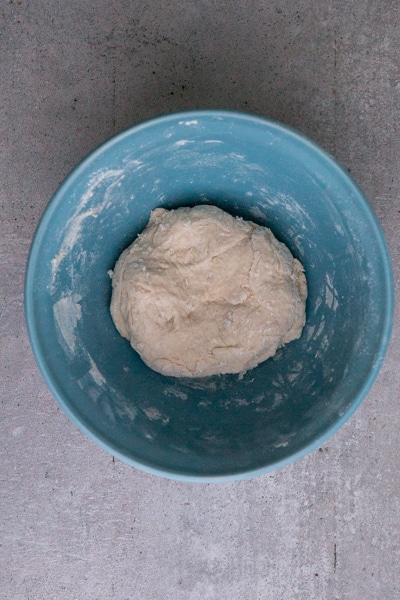
Cover the bowl with plastic wrap and let rise in a cool dry area for 8-12 hours.
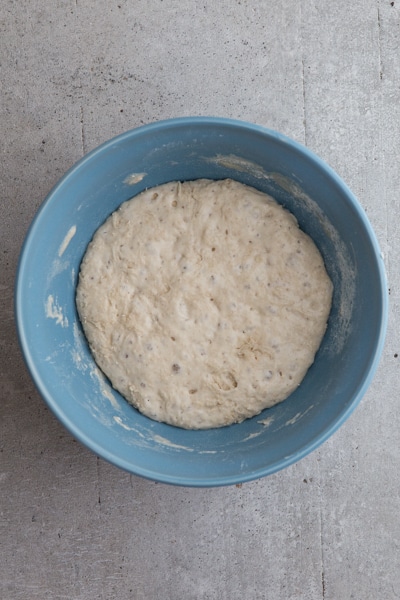
In the bowl of the stand up mixer whisk together the flour, yeast and salt, then add the water and biga.
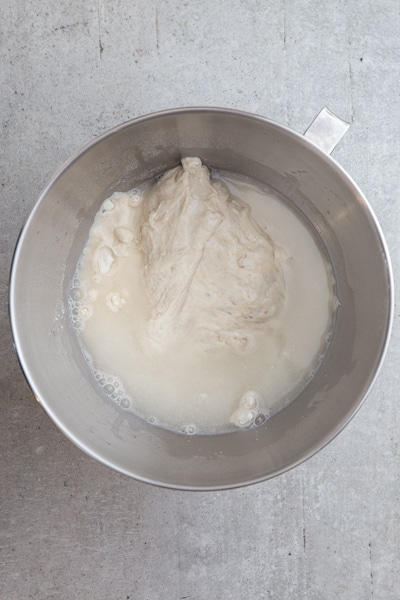
With the flat beaters mix until the mixture starts to come together for about 2-3 minutes.
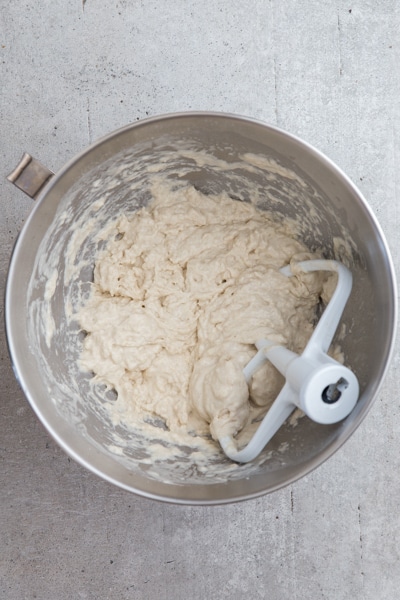
Then switch to the dough hook and knead for another 3 minutes.
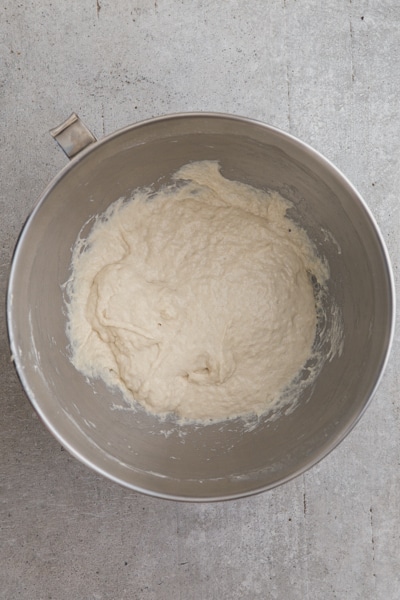
With the help of a spatula place the dough in a lightly oiled bowl, cover with plastic wrap.
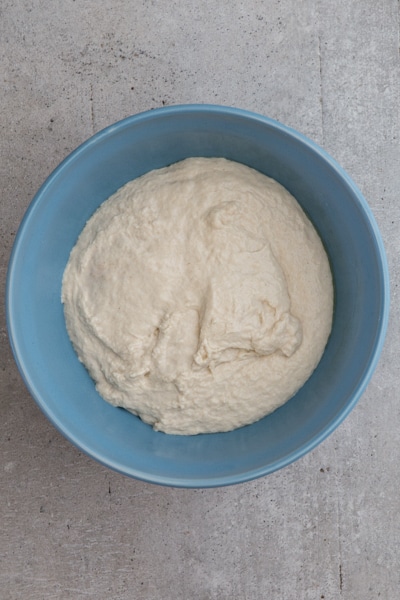
Let rise in a warm draft free area for about one hour or until doubled in bulk.

Move the dough to floured flat surface, sprinkle the top of the dough with flour and divide into two parts.
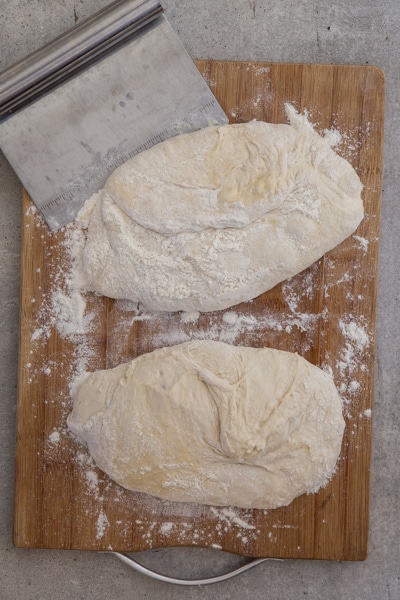
Form each part into an oblong shape, place on parchment paper that is lightly sprinkled with flour, then lightly sprinkle the dough with flour.

Cover with a clean tea towel and let rise 1 hour or until doubled in bulk.

Place a baking sheet (upside down) or a baking stone in the oven before pre-heating the oven. Don’t forget to place an empty oven proof cake pan on the bottom of the oven also.
Before putting the dough in the oven add either a cup of boiling water or some ice cubes (8-10) in the cake pan, then quickly & carefully place the parchment paper and bread on the cookie sheet or baking stone and bake for approximately 20 minutes.
Move the baked bread immediately to a wire rack to cool.
What is a Biga?
You may think that a Poolish and a Biga are the same, but the main difference is that a Poolish is a liquid dough and a Biga is a solid dough.
A Biga is a type of rise used in Italian baking. Many popular Italian breads, including a ciabatta and Pandoro, are made using a Biga.
The addition of a Biga is said to add more flavour to the finished product and is also used in breads that need a light, open texture with holes.
Why add a pan of water while the bread is baking?
Adding water to an oven creates a moistened environment, this allows the bread to rise easier by delaying the setting of the crust. It makes bread deliciously light and crusty. The best way is to put an oven safe pan in the oven while re-heating then add a cup of boiling water or some ice cubes to the pan, place the bread in the oven and bake.
Reasons dough doesn’t rise
There are quite a few reasons why the dough doesn’t rise, the main ones being, your yeast has expired or dead, the room where your bread is rising is too cold, so more time is needed and your liquid is too hot which killed the yeast.
The best temperature for bread to rise in, is 80F / 26C. The best temperature to for the biga to rise in is 71F / 22C, if you home is warmer than that, then the best place to put the biga is in the fridge.
When you remove it from the fridge, be sure to let it come to room temperature, about 45-60 minutes before continuing with the recipe.
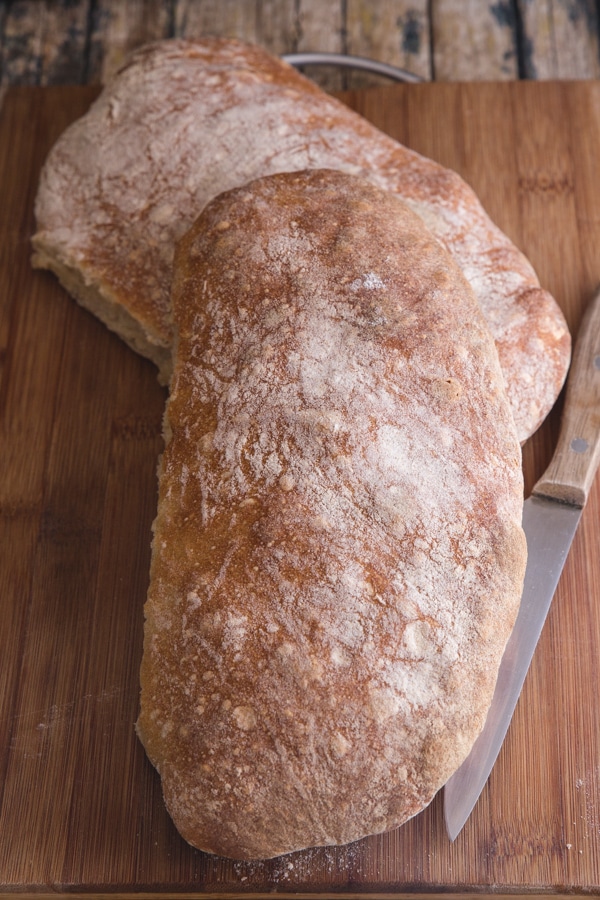
How to tell when the bread is done
There are three ways to tell when the bread is done, the first is by looking at the colour of the bread, which is usually a light to dark golden brown (depending on the bread), the second is by knocking on the bottom of the bread, if there is a hollow sound it usually means the bread is done and the third is by the internal temperature which should be 190F (88C) or 200F (93C) for Brioche type breads.
What are the best ways to eat Ciabatta?
In Italy we like to use slices for a simple sandwich, or even open faced sandwiches, topped with Italian cold cuts, such as prosciutto or salami. It also makes a great dipping bread or even drizzled with olive oil.
Be sure to serve this bread with your favourite Soup , Stew or even Pasta dish. You need something to soak up the leftover sauce in your dish!
How to store the bread
It should be stored in an airtight bag, it will keep for up to three days at room temperature. The baked cooled bread can also be frozen, place in freezer safe bags or container.
Place the frozen bread in the fridge to thaw, then warm in the oven before serving.
More delicious Bread Recipes
- Hot Cross Buns Recipe
- Fast & Easy No-Knead Bread
- Homemade Whole Wheat Bread
- Italian Focaccia Bread
- Italian Crescente Bolognese Recipe
So if you have always wanted to try making bread, then why not give this Traditional Italian Ciabatta a try and let me know how it goes. Enjoy!


Traditional Italian Ciabatta Bread
Ingredients
FOR THE BIGA
- 1 cup + 2 tablespoons all purpose or bread flour (146 grams)
- 1/8 teaspoon active dry yeast
- 1/2 cup lukewarm water (temperature 105F / 40C) (118 grams)
FOR THE DOUGH
- 1 1/2 cups all purpose or bread flour (195 grams)
- 1 1/2 teaspoons active dry yeast
- 1 teaspoon salt
- 3/4 cup lukewarm water (temperature 105F / 40C) (176 grams)
Instructions
- First make the biga, in a medium bowl combine the flour and yeast then add the water and stir to combine. Cover the bowl with plastic wrap and let rise in a cool dry area for 8-12 hours. If your house is on the warm side then place the biga in the fridge for 8-12 hours, remove from the fridge and let it come to room temperature for about 45-60 minutes.
- In the bowl of the stand up mixer whisk together the flour, yeast and salt, then add the water and biga. With the flat beaters mix until the mixture starts to come together for about 2-3 minutes. Then switch to the dough hook and knead for another 3 minutes. This is a soft sticky dough.
- With the help of a spatula place the dough in a lightly oiled bowl, cover with plastic wrap and let rise in a warm draft free area for about one hour or until doubled in bulk.
- Move the dough to floured flat surface, sprinkle the top of the dough with flour and divide into two parts. Form each part into an oblong shape, place on parchment paper that is lightly sprinkled with flour, then lightly sprinkle the dough with flour. Cover with a clean tea towel and let rise 1 hour or until doubled in bulk.
- Place a baking sheet (upside down) or a baking stone in the oven, and an empty oven proof cake pan on the bottom of the oven, then pre-heat the oven to 450F (230C)
- Before putting the dough in the oven add either a cup of boiling water or some ice cubes (about 8) in the cake pan, then quickly & carefully place the parchment paper and bread on the cookie sheet or baking stone and bake for approximately 20 minutes.Move the baked bread immediately to a wire rack to cool. Enjoy!

Excellent- I did it a little differently by using a sour dough starter so as to not use as mischief yeast, but the finished product came out the same and it’s delicious- I will be making again
Hi Ronnie, thanks and great idea using a sourdough starter. Take care!
Hi,
Loved this Ciabatta, I made it and the flavour and texture were fantastic. I find that it was a bit flat in then ens, even though I had good rise at both proofing. Any advise? Thanks
Hi Yariela, glad you liked it and yes it should be on the flat side, Ciabatta in English means slipper, therefore flat. 🙂
Good morning,
I made the Biga last night, this morning its watery,
I followed your direction. What did I do wrong.
Thank you
Hi Joe, the biga should be looser (as in the photo), but by liquidy I really don’t know exactly what that means. Is there water on top? Let me know.
Could you substitute 2 tablespoons of sourdough starter for the yeast in the biga if you adjusted the flour and water a bit
Hi Marty, yes I think that would work. Let me know how it goes. Take care!
Thanks
Mine did not have a lot of holes like yours. I followed the instructions completely and had all fresh ingredients. Any tips?
Hi Brooke, try to handle it as little as possible, this way you won’t break the air bubbles. Try not to add too much extra flour, the wetter the dough the more holes it will have. Try using a bread flour if you didn’t. Hope this helps. Let me know.
Hi Rosemary,
Is it ok to keep the “Biga” in the fridge for longer than 8-10 hours? Thank you
Hi Jale, yes you can keep it in the fridge for up to 2-3 days. 🙂
i used to enjoy ‘sweet focaccia’ at starbucks in the 90’s, early 2000’s – brushed with olive oil and with 10x sugar on top – – till discontinued in later 2000’s. bad move 🙁
your recipe came very close. great texture, i made in balls in pan as my grandmother used to do – and brushed w/olive oil…excellent.
*** very CURIOUS trivialities:
• why not just place dough to rise on pan they’ll be baked on?
• why baking sheet upside down?
• why ice cubes or boiling water, why not just water? in the …
• oven-proof cake pan – isn’t ‘oven-proof’ obvious?
would love to hear your reasons for these details that confused me
thanx!
gail
Hi Gail, the cookie sheet has to heat in the oven so you can’t let the dough rise on the sheet. You place it upside down because it is easier to move the bread onto the pan, you don’t have to lift it over the edges. Boiling water or ice cubes produces steam in the oven when the bread is baking which makes for a better crust, you could probably use room temperature. Not everyone knows oven proof, especially new bakers. 🙂 Hope this helps.
Greetings from Mauritius! Recently discovered your blog and absolutely love it! This Ciabatta has become a big family favorite. My daughter absolutely loves it. My son is more for your olive oil buns that he eats constantly I can’t make enough of either 😂. So thank you very much. Do miss Italy – we were regularly visiting before all this Corona and can’t wait to get back.
Hi Julie, my wonderful brother-in-law was from Mauritius and my sister always talks about how beautiful it is. Thanks so much, so glad your kids love the bread recipes. Take care and hopefully you can visit some day soon. Take care and have a great weekend.
Thank you for sharing your tasty recipe.
Tried and tested and bellissimo !!!!
Hi Gary & Sarah, thanks so much, glad you enjoy the recipes. Have a great week.
Rosemary your ciabatta bread are beautiful , im always afraid to do bread it just doesnt agree with me, but yours looks so easy and your Italian recipes too, great way to make 2 loaves. im going to try it and im going to follow your instructions as you wrote them thank you for your recipes theyre wonderful grazie in bocca al lupo ciao
Hi Miriam, thanks so much, let me know how the bread turned out. Buona fortuna!
For traditional ciabatta bread what changes to the recipe should be made if you want to add sliced pimiento olives ?
Thanks
Hi Mike, there are no changes to be made add them in at the last minute of kneading. You might need to add a bit more flour. Let me know how it goes.